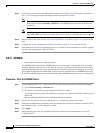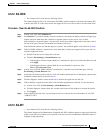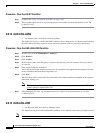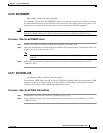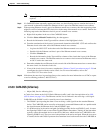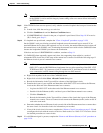
2-30
Cisco ONS 15327 Troubleshooting Guide, R3.4
March 2004
Chapter 2 Alarm Troubleshooting
Alarm Procedures
Procedure: Clear the BKUPMEMP Alarm
Step 1 Verify that both XTC cards are powered and enabled by confirming lighted ACT/STBY LEDs on the
XTC cards.
Step 2 If both XTC cards are powered and enabled, reset the active XTC card to it standby and make the standby
XTC card active. Complete the “Reset the Active XTC Card in CTC” procedure on page 2-129.
Verify that the active card you reset is now standby. The ACT/STBY LED of this card should be amber,
and the newly active XTC card LED should be green.
Step 3 If the XTC you reset does not reboot successfully, or the alarm has not cleared, call TAC
(1-800-553-2447). If the TAC technician tells you to reseat the card, complete the “Remove and Reinsert
(Reseat) the Standby XTC” procedure on page 3-3. If the TAC technician tells you to remove the card
and reinstall a new one, follow the “Physically Replace a Card” procedure on page 2-130.
Note When replacing a card with an identical type of card, no additional CTC provisioning is
required.
2.6.30 BLSROSYNC
• Major (MJ), Service Affecting (SA)
The BLSR Out Of Synchronization (BLSROSYNC) alarm is caused when you attempt to add or delete
a circuit and a node on a working ring loses its DCC connection because all transmit and receive fiber
has been removed. CTC cannot generate the ring table and causes the BLSROSYNC alarm.
Warning
Invisible laser radiation might be emitted from the end of the unterminated fiber cable or connector.
Do not stare into the beam directly with optical instruments. Viewing the laser output with certain
optical instruments (for example, eye loupes, magnifiers, and microscopes) within a distance of 100
mm might pose an eye hazard. Use of controls or adjustments or performance of procedures other than
those specified might result in hazardous radiation exposure.
Procedure: Clear the BLSROSYNC Alarm
Step 1 Reestablish cabling continuity to the node reporting the alarm.
When the DCC is established between the node and the rest of the BLSR, it becomes visible to the BLSR
and should be able to function on the circuits.
Step 2 If alarms occur when you have provisioned the DCCs, see the “EOC” section on page 2-48.
Step 3 If the alarm does not clear, log onto http://www.cisco.com/tac for more information or call TAC to report
a service-affecting problem (1-800-553-2447).



